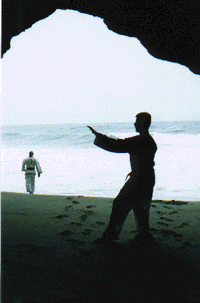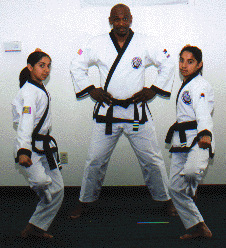FREMONT TANG SOO DO NEWSLETTER
February 2000
What makes a traditional martial arts school?
By Glen Evan, Cho Dan
I have been thinking about what makes a traditional martial arts school, and have identified three aspects of traditional teaching that I think make First Tang Soo Do of Fremont a traditional school. Teaching with an emphasis on usage, natural body movement and breathing, and the development of virtue, are traditional elements of our school.
The Dictionary defines a tradition as “the passing down of elements of a culture from generation to generation, especially by oral communication.” By training in Tang Soo Do, we are receiving elements of a culture, specifically having to do with individual martial techniques, handed down to us through oral and visual communication. To this extent Tang Soo Do is a tradition, but I feel that what makes an art or school traditional has as much to do with the way the art is handed down, as what is handed down.
The fighting arts have been developed over many centuries with the preservation of the individual practitioner as their main emphasis. Historically, the benefits of being trained in martial arts could be that you survived an attack on your village by bandits, or that you walked off a battlefield, rather than were carried off on a stretcher. This threat to life in the early days of the development of martial arts leant an immediacy to martial training. There is a traditional story about this immediacy that illustrates what martial training meant to early teachers and practitioners.
|
A teacher and his student were walking in the woods one day, when they observed a fox chasing a rabbit. The student turned to the teacher and asked who would win this contest, the fox or the rabbit. The teacher replied that the rabbit would win, and the student asked why this was so. The teacher said “because the fox is only running for its dinner, but the rabbit is running for its life.”
This immediacy comes down traditionally to us today when we are taught to create an imaginary opponent, and to think of the actual usage of the techniques we are learning. We invoke that seriousness and immediacy that the early practitioners had when they were learning and developing the arts, when we see the ‘fox’ in front of us and use the best technique to defeat it. When a traditionally trained student is doing a form, they should be able to see their opponents all around them, and observers should be able to see their opponents as well.
|  |
|
Another traditional aspect of the teaching of this art is an emphasis on natural body movement. These fighting arts were developed in natural surroundings and came about through observation of man and animals in nature. This observation of natural behavior lead to determining what the most effective and efficient martial technique would be in any given situation. It was quickly seen that natural body movement and breathing, was the quickest and most efficient way to fight. When we teach with an emphasis on natural body movement and breathing, we are likely to rediscover some of the meaning behind the movements we are learning today, and get closer to our tradition
The other aspect of traditional training I feel is important is the emphasis on virtue along with the martial fighting techniques within a school. The Do in Tang Soo Do means ‘Way’ and this way of life is embodied in the tenets and codes of the tradition. Tang Soo Do is one of the few arts that openly teaches proper conduct and integrates virtues into the art’s training. These virtues are taught mainly through their use by the teachers and students in the school. In other words, traditional training is most commonly done by example.
|
These are just a few observations on what makes a traditional school. There are many other approaches to this subject, but the focus that comes from the immediacy of the original martial training, the emphasis on natural body movement and breathing, and the following of the ‘Way’ of the virtues of our art, makes us true to our lineage as traditional martial artists.
The Show Continues
"David Bell's Tang Soo Do Show" continues to air on ATT/TCI Cable's community access. In Fremont, tune in to Channels 3 or 22 on Monday nights at 7:30 to 8:00 p.m. In Newark, tune in to Channel 6 at 2:00 p.m. on Tuesdays.
In January, we taped our 20th episode!
I would like to thank the students of First Tang Soo Do of Fremont for their continuing dedication to this project.
Mr. Bell
|
Mind body and Spirit
On September 14, 1999, the third year of our study group will begin. The study group was developed for students from 1 st to 12th grade to offer a more structured, less distracting study environment. The goal is to help students achieve standards of grades equal to the standards to which they are held in their formal Tang Soo Do physical training.
|  |
|
The group meets every Tuesday and Thursday from 6:00 to 8:00 pm throughout the school year.
Thanks to Monica and Marcela Munoz, both E Dans, for their leadership on this very special study program!
|
Mr. Bell
The Effect of Tang Soo Do
After two years of physical inactivity, returning to Tang Soo Do training has been an obligation and a challenge. Although it’s hard to choose to work out over seeing friends, I feel healthier and like I’ve exerted myself, pushed myself physically, for the first time in two years. That kind of exertion has made me feel more alert and aware than I have, but mostly I feel more responsible to priortize obligation before free will.
Endurance-wise I am basically equal to a white belt, but technique cannot face like endurance. This has made my experience like a beginning white belt and a senior student. The years of fine-tuning come back easily after I relearned all the basics. The difference between out-of-shape white belts and out-of-shape Cho Dan Bos is basically the higher level of focus on technique.
Since the beginning, Tang Soo Do has required the most concentration than any other sport, class, or activity. Physically, mentally, and spiritually, Tang Soo Do demands the highest level of concentration. Because Tang Soo Do is so energetically demanding, I both look forward to and dread class. Even though it is easier to take the day off, the feeling of pushing myself to the limit and the awareness of what I am capable of is a good feeling. Drifting through life is easy, but it doesn’t give satisfaction.
The Tang Soo Do identity is not how others see ma as a blue belt in martial arts, but how I see myself. There are two kinds of students in Tang Soo Do, those who challenge themselves and have a sense of obligation, and those who drop out when it gets too hard and do what comes easiest: the drifters in life and those who look for purpose. Tang Soo Do resides in the part of my mind that thinks for the overall good, and the easy-way-out part constantly fights alongside it.
Becoming a blue belt has meant “stepping up.” When promoted to the next level not onlyu is it in rank, but in understanding and focus. I watched two second dan black belts, a blue belt, and a pre-brown belt go through a form and the ranks became apparent in their forms. They could have all been wearing white belts, but it would still be obvious what they really were.
Anonymous 16 year old female Cho Dan Bo
Back issues:
Summer 1999
Spring 1999
|
|






